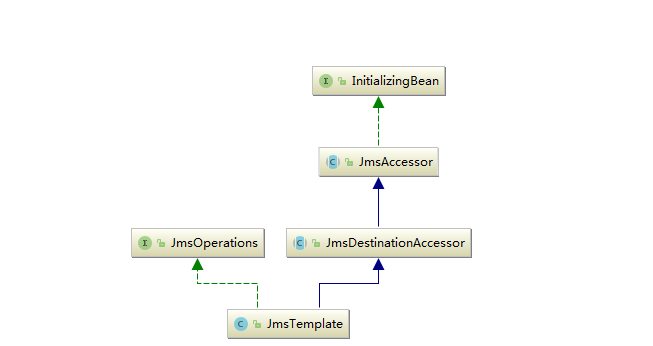尽管消息接收可以使用消息监听的方式替代模板方法,但是发送的时候是无法代替的,在Spring中必须要使用JmsTemplate提供的方法来进行发送操作,可见JmsTemplate类的重要性,那么我们对于整合消息服务的分析就从JmsTemplate开始。
JmsTemplate
在上一篇文章中,我们看到了Spring采用了与JDBC等一贯的套路,为我们提供了JmsTemplate来封装常用操作。下面看一下它的类图:

提取我们感兴趣的接口InitializingBean,接口方法的实现是在JmsAccessor类中,如下:
public void afterPropertiesSet() { if (getConnectionFactory() == null) { throw new IllegalArgumentException("Property 'connectionFactory' is required"); } }
发现函数中只是一个验证功能,并没有逻辑实现。所以丢掉这里,转向实例代码分析。首先以发送为例,在Spring中发送消息可以通过JmsTemplate中提供的方法来实现。
public void send(final Destination destination, final MessageCreator messageCreator) throws JmsException { execute(session -> { doSend(session, destination, messageCreator); return null; }, false); }
这个函数的风格不得不让我们回想起JdbcTemplate的类实现风格,极为相似,都是提取一个公共的方法作为最底层、最通用的功能实现,然后又通过回调函数的不同来区分个性化的功能。
我们首先查看通用代码的抽取实现。
1.通用代码抽取
public <T> T execute(SessionCallback<T> action, boolean startConnection) throws JmsException { Assert.notNull(action, "Callback object must not be null"); Connection conToClose = null; Session sessionToClose = null; try { Session sessionToUse = ConnectionFactoryUtils.doGetTransactionalSession( obtainConnectionFactory(), this.transactionalResourceFactory, startConnection); if (sessionToUse == null) { //创建connection conToClose = createConnection(); //创建session sessionToClose = createSession(conToClose); //是否开启向服务器推送连接信息,只有接收消息时需要,发送时不需要 if (startConnection) { conToClose.start(); } sessionToUse = sessionToClose; } if (logger.isDebugEnabled()) { logger.debug("Executing callback on JMS Session: " + sessionToUse); } //调用回调函数 return action.doInJms(sessionToUse); } catch (JMSException ex) { throw convertJmsAccessException(ex); } finally { //关闭session JmsUtils.closeSession(sessionToClose); //释放连接 ConnectionFactoryUtils.releaseConnection(conToClose, getConnectionFactory(), startConnection); } }
上述代码封装了connection以及session的创建操作。在准备工作结束后,调用回调函数将程序引入用户自定义实现的个性化处理。
2.发送消息的实现
有了基类的辅助实现,使得Spring更加专注于个性的处理,也就是说Spring使用execute方法中封装了冗余代码,而将个性化的代码实现放在了回调函数doInJms中。在发送消息的功能中回调函数通过局部类实现。
execute(session -> { doSend(session, destination, messageCreator); return null; }, false);
此时的发送逻辑已经完全转向了doSend方法,这样使整个功能实现变得更加清晰了。
protected void doSend(Session session, Destination destination, MessageCreator messageCreator) throws JMSException { Assert.notNull(messageCreator, "MessageCreator must not be null"); MessageProducer producer = createProducer(session, destination); try { Message message = messageCreator.createMessage(session); if (logger.isDebugEnabled()) { logger.debug("Sending created message: " + message); } doSend(producer, message); // Check commit - avoid commit call within a JTA transaction. if (session.getTransacted() && isSessionLocallyTransacted(session)) { // Transacted session created by this template -> commit. JmsUtils.commitIfNecessary(session); } } finally { JmsUtils.closeMessageProducer(producer); } }
在发送消息还是遵循着消息发送的规则,比如根据Destination创建MessageProducer、创建Message,并使用MessageProducer实例来发送消息。
3.接收消息
我们通常使用JmsTemplate.receive(destination)来接收简单的消息,那么这个功能Spring是如何封装的呢?
public Message receive(Destination destination) throws JmsException { return receiveSelected(destination, null); }
public Message receiveSelected(final Destination destination, @Nullable final String messageSelector) throws JmsException { return execute(session -> doReceive(session, destination, messageSelector), true); }
protected Message doReceive(Session session, Destination destination, @Nullable String messageSelector) throws JMSException { return doReceive(session, createConsumer(session, destination, messageSelector)); }
protected Message doReceive(Session session, MessageConsumer consumer) throws JMSException { try { // Use transaction timeout (if available). long timeout = getReceiveTimeout(); ConnectionFactory connectionFactory = getConnectionFactory(); JmsResourceHolder resourceHolder = null; if (connectionFactory != null) { resourceHolder = (JmsResourceHolder) TransactionSynchronizationManager.getResource(connectionFactory); } if (resourceHolder != null && resourceHolder.hasTimeout()) { timeout = Math.min(timeout, resourceHolder.getTimeToLiveInMillis()); } Message message = receiveFromConsumer(consumer, timeout); if (session.getTransacted()) { // Commit necessary - but avoid commit call within a JTA transaction. if (isSessionLocallyTransacted(session)) { // Transacted session created by this template -> commit. JmsUtils.commitIfNecessary(session); } } else if (isClientAcknowledge(session)) { // Manually acknowledge message, if any. if (message != null) { message.acknowledge(); } } return message; } finally { JmsUtils.closeMessageConsumer(consumer); } }
实现的套路还是和发送差不多,同样还是使用execute函数来封装多余的操作,而最终的目的还是通过consumer.receive()来接收消息,其中的过程就是对于MessageConsumer的创建以及一些辅助操作。
参考:《Spring源码深度解析》 郝佳 编著: